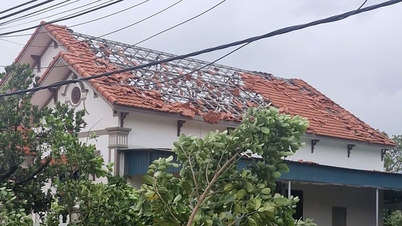Ngoc Linh ginseng is considered a national treasure of Vietnam because of its rarity and high medicinal properties. Over the years, the seeds, flowers, leaves, and roots of ginseng have all been precious and their prices have increased to tens of millions of dong per root. But recently, they have been widely sold online for only a few hundred thousand dong per root or tree.
Mr. Hoa in Lai Chau is selling 2 kg of Ngoc Linh ginseng over 7 years old at a retail price of 250,000 VND per root and said he has a few kg every month. According to him, this is the Ngoc Linh ginseng variety that he imported from Kon Tum when it was only a few months old and brought to Lai Chau to grow for many years.
“My garden has a few thousand plants, each month it produces 1-2 kg to sell to the market. Customers can check the quality before paying. The quantity is limited, so if customers buy late, there will be no goods,” said Mr. Hoa.

“Ngoc Linh Ginseng” is being sold at super cheap prices on the online market. Photo: Hong Chau
Similarly, another source in Lai Chau also sells 5-year-old varieties for 300,000 VND per tuber. He said that because they are grown, the price is cheaper than those taken from the forest. This type weighs 50-70 grams per tuber.
In addition to selling tubers, he also sells 3-4 year old seedlings for only about 200,000 VND and a combo of 10 Ngoc Linh ginseng seeds for about 50,000 VND.
Not only on social networks, on e-commerce sites such as Lazada, Shopee, Ngoc Linh ginseng roots, seedlings and seeds are also sold for several hundred thousand dong. In particular, at online stores, the selling price is about 200,000-300,000 dong for a 4-year-old plant. The type over 5 years old including roots and leaves weighing up to 250 grams costs 649,000 dong. This is 80-85 times cheaper than the Ngoc Linh ginseng sold at companies in Kon Tum.
When asked about the Ngoc Linh ginseng certification certificate, these sales establishments all said they did not have it yet. Some others promised to send the certification certificate later but in the end, none responded.
Meanwhile, according to VnExpress 's records at Ngoc Linh ginseng gardens in Kon Tum, the selling price of each seed ranges from 110,000 to 120,000 VND. The 1-year-old seedling costs 280,000 VND, the 2-year-old is 600,000 VND, the 3-year-old is 1.2-1.5 million VND, the 4-year-old is 2 million VND.
For ginseng roots, the type weighing 50-70 grams costs 7-12 million VND per 100 grams. The type weighing more than this costs 14-15 million VND per 100 grams. Particularly for the type weighing 200 grams per root, the price is up to 30 million VND per 100 grams. However, this type of large weight is very rare and most households have to grow it for over 15 years or harvest it naturally to have it available for sale on the market.
Ms. Dang Thi Kim Thao - a gardener who owns 2,000 Ngoc Linh ginseng plants in Kon Tum - said that the products sold online at cheap prices are mostly Chinese Panax pseudoginseng or Lai Chau ginseng (which contain very low saponin). Ngoc Linh ginseng in Kon Tum is very expensive because it contains 52 rare types of saponin and only they have the active ingredient MR2.
Saponin is a substance that is beneficial to health. The more saponin a ginseng contains, the better its quality. According to the Ngoc Linh Ginseng Research and Development Center, Korean and Korean ginseng only have about 26 saponins with a common chemical structure, while Vietnamese Ngoc Linh ginseng has up to 56 saponins (more than double).
MR2 is a dammaran saponin compound containing ocotillol with majonosid-R2, accounting for more than 50% of the saponin content in ginseng. This substance helps Ngoc Linh ginseng to be processed into medicinal herbs to treat many dangerous diseases. Therefore, this is considered the most precious ginseng in the world .
Looking at the products posted by the seller, Ms. Thao said that at first glance, they look quite similar, but if you look closely, you will see that the leaves, stems, flowers, and roots are completely different. “Lai Chau ginseng leaves are usually big and round. Ngoc Linh leaves are long, thin, and have green stems (some wild plants have purple stems). Fake Ngoc Linh ginseng leaves have a hairy front and less hairy back than the real ones,” Ms. Thao said.
Regarding the roots, real Ngoc Linh ginseng has eyes that are deeply sunken into the stem, are not perfectly round and grow unevenly. When washed, the roots are yellow-brown or gray-green. Meanwhile, fake ginseng has thick eyes that grow in a straight line.
In addition, she said that the Ngoc Linh ginseng over 10 years old in the natural garden, the biggest root is only about 100 grams, but on the internet many roots weigh up to 250 grams. This shows that the product does not guarantee quality, if the variety is from Ngoc Linh, this is a product that uses stimulants to create roots with such a large weight.
Sharing the same opinion, Mr. Tran Duc An, Director of Ngoc Linh Tu Mo Rong Ginseng Joint Stock Company (Kon Tum), said that although his ginseng garden has engineers taking care of it with full techniques, the survival rate is not high. Each year, the yield for harvest in the garden is low, but on the internet, you can buy as much as you want. Many establishments also arrange hundreds of ginseng roots in various bonsai shapes and sell them at "cheap as free". In fact, Mr. An said that most of them are Chinese Panax pseudoginseng roots disguised as Ngoc Linh ginseng.
“In Kon Tum and Quang Nam, the rate of Ngoc Linh ginseng propagation is increasing but the output supplied to the market is still very low,” said Mr. An. According to him, to avoid losing money, in addition to distinguishing the shape, customers can bring the product for DNA testing.
Recently, in Kon Tum, two ginseng companies have been granted the right to use the geographical indication “Ngoc Linh” for ginseng root products by the authorities. Therefore, consumers should buy at reputable addresses and have been granted a certified indication.
Ginseng growers and businesses in Kon Tum said that the situation of fake Lai Chau and Chinese products, labeled “Ngoc Linh”, is rampant on online markets, greatly affecting the Ngoc Linh ginseng brand. Therefore, these units requested that State agencies have policies to handle and prevent these phenomena.
Source



![[Photo] Super harvest moon shines brightly on Mid-Autumn Festival night around the world](https://vphoto.vietnam.vn/thumb/1200x675/vietnam/resource/IMAGE/2025/10/07/1759816565798_1759814567021-jpg.webp)




































































































Comment (0)